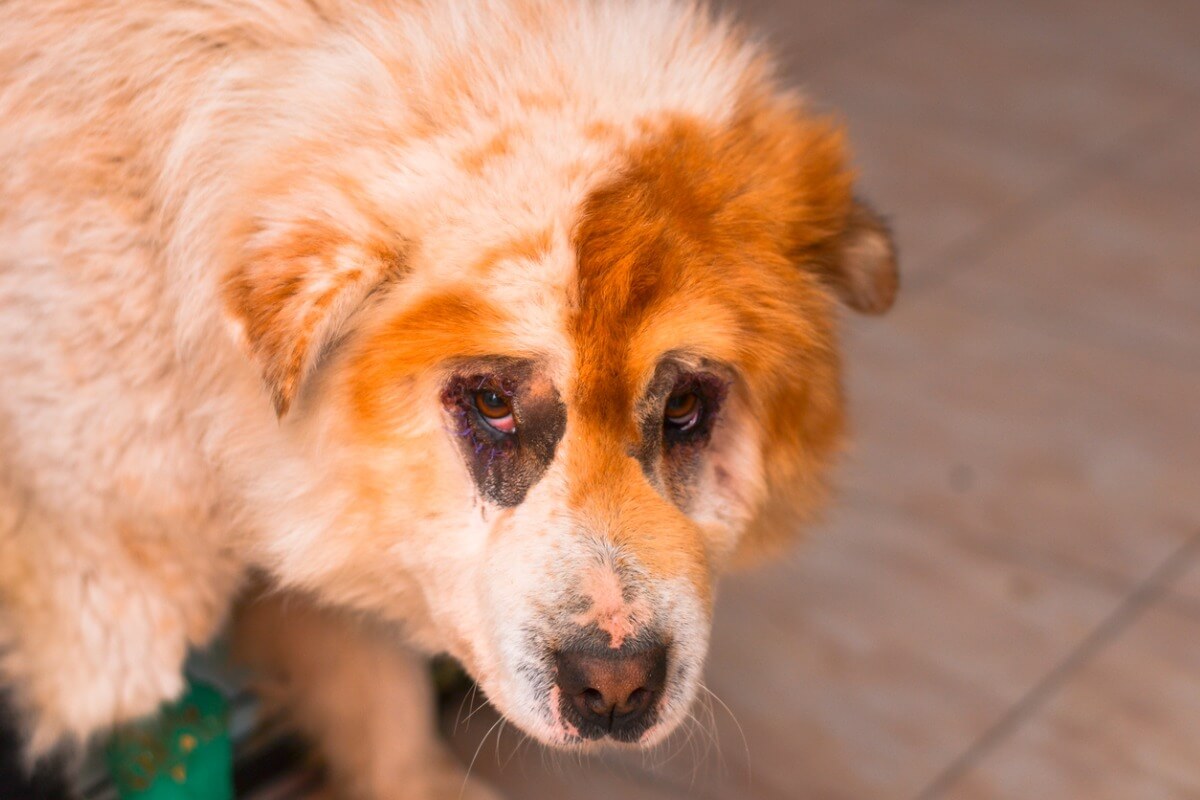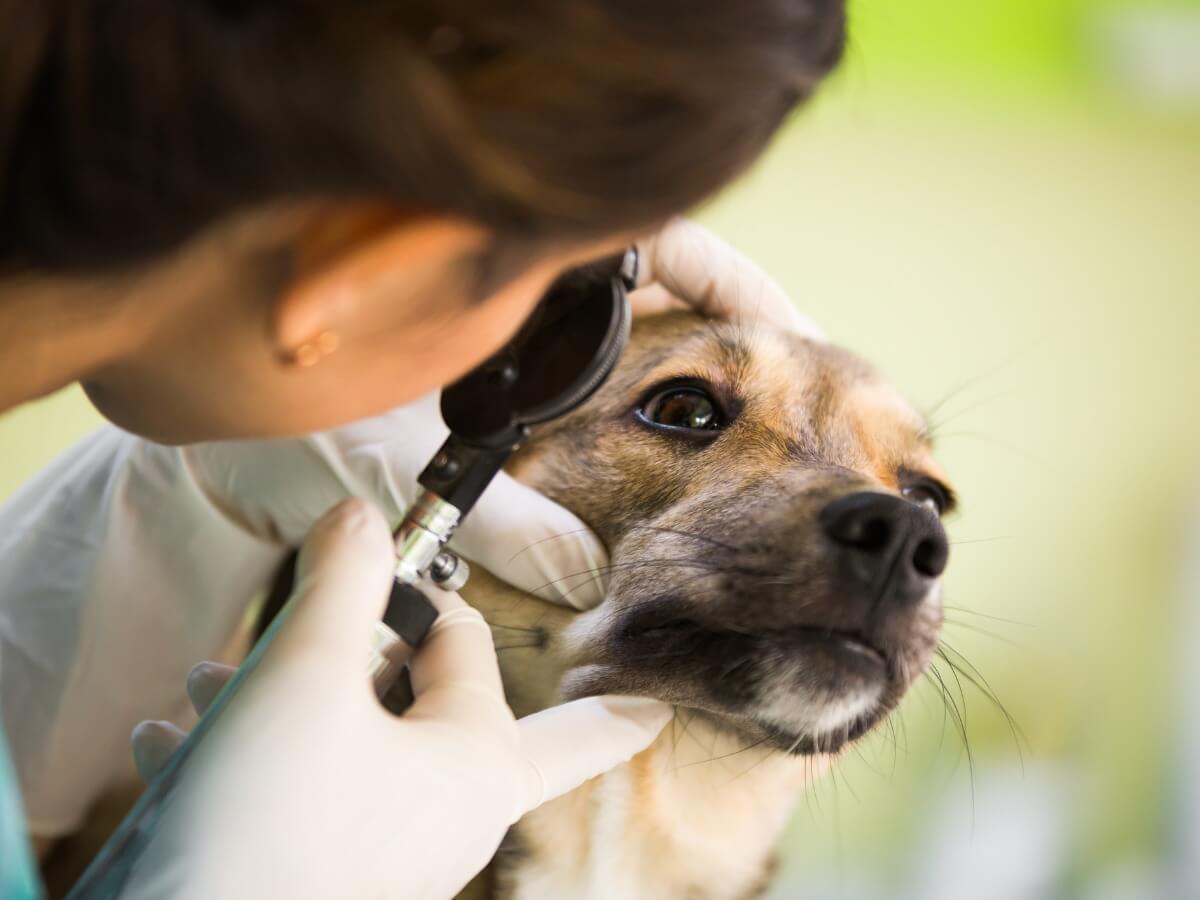Entropion in Dogs: Causes, Symptoms and Treatment

As we all know, the sense of smell is the most acute sense in dogs. However, sight isn’t far behind, because, thanks to it, canines are able to sense what’s going on around them, move accordingly, and feel safe in new areas. Entropion in dogs is one of those conditions that, if left untreated, can take away your pet’s vision and greatly worsen their quality of life.
In the following lines, we’re going to tell you what entropion in dogs is, what its main symptoms are, and how to treat it. Don’t stop reading, because this condition is more serious than its etiology suggests at first.
What’s entropion in dogs?
Dogs’ eyes constantly adjust to receive the right amount of light from the environment. The eyeballs are contained within the cranial orbits, which are lined by nerves, muscles, blood vessels, and structures that allow fluids to drain.
The white part of the dog’s eye is the sclera, which is covered by a mucous membrane known as the conjunctiva. The iris is the colored circular section in the center of the globe and the pupil is the black nucleus. Depending on the contraction or dilation of the pupillary sphincters, the pupil either dilates to let in more light or contracts to limit the light stimulus.
The cornea is one of the most important parts of the ocular apparatus in animals, as it protects the aforementioned tissues and helps focus the light beam onto the retina, the structure that contains the photoreceptors needed to transmit the collected information to the brain. Unfortunately, this delicate structure can be damaged by phenomena such as entropion.
As indicated by the veterinary portal VCA Hospitals, entropion in dogs is an abnormality in the eyelids that causes them to curl inwards. The condition causes the eyelashes and other types of hair to rub against the cornea and cause pain, corneal ulcerations, perforations, or pigmentary developments that interfere with vision.
Although entropion is a problem that originates in the eyelids, it can lead to blindness.

Causes of entropion in dogs
Entropion can have several causes, but it’s an eminently hereditary pathology. Now we’re going to show you some events that tend to propitiate it.
Genetics
As indicated by the portal Veterinary Partner, entropion is usually congenital. In these cases, the affected dog will begin to show clinical signs before it’s one year old. Experts don’t know exactly what gene may predispose dogs to develop this condition, but they do know that certain breeds are much more likely to suffer from it.
Some of the breeds most likely to have congenital entropion are the Akita, Staffordshire Terrier, Basset Hound, Bloodhound, Bulldog, Chesapeake Bay Retriever, Clumber Spaniel, Cocker Spaniel, and the Labrador Retriever, among others. Prominent eyes and drooping eyelids appear to play a role in the predisposition, but don’t explain the condition on their own.
Eye pain or malformations
Eyes that are affected by a previous condition often pull “inward” into the sockets, making the eyelids droop and fold in on themselves. The eye defect that causes this entropion can be congenital or acquired throughout life.
Skin problems
Some dermatological conditions cause keratinization and thickening of the skin, which also affects the eyes and eyelids. Thus, the physiological change in the eyelids can cause the eyelids to “fold” inward and lead to entropion.
Age
Age causes the skin of dogs to become flaccid. This is especially true in breeds that already have drooping eyelids, such as the Cocker Spaniel. Entropion associated with old age in these and many other purebred dogs is quite common.
Wounds and injuries
Wounds and injuries to the eyes sometimes cause damage to the eyelids, which heal poorly if care by the guardian is inadequate. Therefore, a blow during play or walking can lead to entropion.
Symptoms
Symptoms of entropion in dogs are caused by the eyelids and eyelashes rubbing against the cornea and the eyeball in general. Some of the most prevalent signs in this condition are as follows:
- Constant squinting of the eyes
- Excessive tearing
- A purulent discharge in the affected area, indicating a bacterial infection
- Apparent redness and swelling around the affected eye (or both)
- Conjunctivitis, i.e., inflammation of the conjunctival layer of the eyeball
- Excessive blinking
- Blepharospasm, or spasm of the eyelid muscles
- Signs of corneal ulcer
In most cases, both eyes are affected at the same time (even if one is more damaged than the other). It should be noted that the vast majority of dogs present symptoms before the first year of age, as it’s almost always a congenital condition.
Diagnosis
In the event of any ocular abnormality, you should take your dog to the vet. Keep in mind that a wound resulting from entropion can become infected and cause very serious conditions in your dog, so do not overlook the clinical signs mentioned above.
Once in the clinic, entropion in dogs is usually diagnosed by external eye examination alone. If the diagnosis is positive, your veterinarian will perform a fluorescein staining test on your dog to detect possible corneal damage. This step is very important, as patients with corneal injury require additional treatment.
Clinical signs usually appear before entropion becomes severe. Therefore, many canines are diagnosed on routine examination.
Treatment of entropion in dogs
The veterinarian can prescribe preventive antibiotics after diagnosis to prevent the cornea from becoming infected (or to fight an established infection), but this will not cure the entropion itself. The only possible solution in all cases is surgery.
The surgical procedure is simple: remove the excess eyelid skin and reposition it by blepharoplasty. The resection area must be sewn up and the stitches are removed 10 to 14 days after the operation, so the dog will have to return to the clinic a short time later. It should be noted that sometimes the surgical procedure is divided into 2 sessions, one major and one minor.
If the animal has a corneal ulcer, this will need to be addressed once the blepharoplasty has been performed. This includes the application of ophthalmic ointments and sanitization of the dog’s eyeball until it improves.
Blepharoplasty isn’t usually performed in dogs 6 months of age or younger. A conservative approach can be taken until they’re older, as one never knows what the cranial structure of canines will be like as adults.

Prognosis of entropion in dogs
The prognosis is excellent in almost all cases. If blepharoplasty is performed in a timely manner, the dog will return to normal in a matter of weeks. However, corneal damage is sometimes irreversible and, in severe cases, the dog may not regain full visual acuity. In addition, one can’t guarantee that the dog may require more than one operation.
All owners of dogs with entropion are advised not to crossbreed them under any circumstances. As it’s a genetic condition, breeding makes it likely that future litters will also have it, and suffer complications from it.
All cited sources were thoroughly reviewed by our team to ensure their quality, reliability, currency, and validity. The bibliography of this article was considered reliable and of academic or scientific accuracy.
- Eyelid entropion in dogs, VCA Hospitals. Recogido a 11 de octubre en https://vcahospitals.com/know-your-pet/eyelid-entropion-in-dogs
- Eye structure and function in dogs, MSD Manuals. Recogido a 11 de octubre en https://www.msdvetmanual.com/dog-owners/eye-disorders-of-dogs/eye-structure-and-function-in-dogs
- Entropion in dogs, veterinary partner. Recogido a 11 de octubre en https://veterinarypartner.vin.com/default.aspx?pid=19239&id=4952708
This text is provided for informational purposes only and does not replace consultation with a professional. If in doubt, consult your specialist.